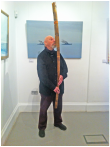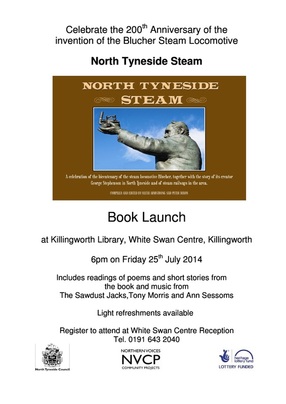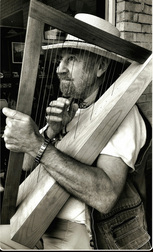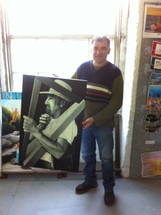Tony was unable to perform 'Out of the Fog' at the Preview due to a sore throat (that's what you get in the fog!) but provided improvisations on Koncovka and Fujara.
‘OUT OF THE FOG’ was written for performance at the preview of Scarborough Artist, Tim Knight’s eponymous Exhibition at Woodend, Scarborough on Friday 7 November 2014. The Exhibition will be open to the Public from 10 November to 18 December 2014. The piece can be accessed as an Mp3 download or as an on demand CD from links on this site. Below is a description of the constituent parts.
OUT OF THE FOG is a faceted piece of words and music, presented as a single track, with unaccompanied song and song poems accompanied and highlighted with harp, lyre, bowed psaltery, sansula, bell, and fujara, about the Bombardment of Scarborough by the German Navy in December 1914. This Bombardment marked a fundamental change in modern warfare being the first enemy attack on an undefended civilian population.
The first song, unaccompanied, ‘Good Fellow Edward’, sets the mood of the pre-war spirit. King Edward VII had died 4 years before but the gay, carefree aesthetic of the Edwardian Period still prevailed. This theme is continued in the following song-poem, ‘Italian Gardens’, accompanied by Sansula.
Harp and the song poem, ‘Out of the Fog’ carry the mood into the grey realisation that war was coming to Scarborough. Lyre is the accompaniment to ‘The Bathing Party’ which presents the clash of an early morning Edwardian ‘dip’ with the looming threat of the advancing battle cruisers. A very British joke and the sound of explosions (thunder tube) take the piece into the Bombardment itself and the panicked reaction of the population in ‘Man with a Parrot’, accompanied by the dissonant tones of a bowed psaltery, ‘Man with a Razor’, accompanied by harp and the plaintiff, ‘Woman with Children’, accompanied by lyre.
There follows an unaccompanied song, ‘Shells for Breakfast’, inspired by Tim Knight’s painting of a chaotic scene at Scarborough Railway Station as some of the population try to escape on the train to Leeds.
‘Flying the Flag’ is a song poem written in the style of a personal testimony, showing the other side of human behaviour, the courageous spirit and selfless heroism of the Police and Coastguard showing a defiant face to the Enemy.
The story then returns to the view from the Italian Gardens in the song poem, ‘Scarborough on Fire’ as the thirty minutes of bombardment draws to a close. As the Battle Cruisers turn away they swing back to fire, ‘The Parting Shot’, potently symbolic in its destruction of the Harbour Lighthouse which was not to be restored for many years.
‘The Silver Bell’, an unaccompanied song, is also symbolically resonant and connects the Scarborough Bombardment to the mood which drove the War on the Western Front forward with angry, patriotic volunteer soldiers sacrificing themselves in this War between Kings and Emperors.
‘Afterword’, returns the scene in Scarborough to calm and normality, as far as the people of that time could know but the last lines carry a foreboding echoed by the closing music on fujara.
OUT OF THE FOG is a faceted piece of words and music, presented as a single track, with unaccompanied song and song poems accompanied and highlighted with harp, lyre, bowed psaltery, sansula, bell, and fujara, about the Bombardment of Scarborough by the German Navy in December 1914. This Bombardment marked a fundamental change in modern warfare being the first enemy attack on an undefended civilian population.
The first song, unaccompanied, ‘Good Fellow Edward’, sets the mood of the pre-war spirit. King Edward VII had died 4 years before but the gay, carefree aesthetic of the Edwardian Period still prevailed. This theme is continued in the following song-poem, ‘Italian Gardens’, accompanied by Sansula.
Harp and the song poem, ‘Out of the Fog’ carry the mood into the grey realisation that war was coming to Scarborough. Lyre is the accompaniment to ‘The Bathing Party’ which presents the clash of an early morning Edwardian ‘dip’ with the looming threat of the advancing battle cruisers. A very British joke and the sound of explosions (thunder tube) take the piece into the Bombardment itself and the panicked reaction of the population in ‘Man with a Parrot’, accompanied by the dissonant tones of a bowed psaltery, ‘Man with a Razor’, accompanied by harp and the plaintiff, ‘Woman with Children’, accompanied by lyre.
There follows an unaccompanied song, ‘Shells for Breakfast’, inspired by Tim Knight’s painting of a chaotic scene at Scarborough Railway Station as some of the population try to escape on the train to Leeds.
‘Flying the Flag’ is a song poem written in the style of a personal testimony, showing the other side of human behaviour, the courageous spirit and selfless heroism of the Police and Coastguard showing a defiant face to the Enemy.
The story then returns to the view from the Italian Gardens in the song poem, ‘Scarborough on Fire’ as the thirty minutes of bombardment draws to a close. As the Battle Cruisers turn away they swing back to fire, ‘The Parting Shot’, potently symbolic in its destruction of the Harbour Lighthouse which was not to be restored for many years.
‘The Silver Bell’, an unaccompanied song, is also symbolically resonant and connects the Scarborough Bombardment to the mood which drove the War on the Western Front forward with angry, patriotic volunteer soldiers sacrificing themselves in this War between Kings and Emperors.
‘Afterword’, returns the scene in Scarborough to calm and normality, as far as the people of that time could know but the last lines carry a foreboding echoed by the closing music on fujara.
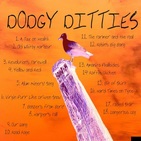
Now Released
DODGY DITTIES
18 Tracks - of what the title suggests.
DODGY DITTIES
18 Tracks - of what the title suggests.
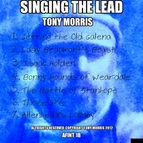
NOW RELEASED short Album of Lead Mining Songs available as a download:Click here
and an on request CD. Here is a bit about the contents:
SINGING THE LEAD
In 2012 Tony Morris was invited to write songs about lead mining, set in Weardale for a projected performance. Due to lack of funding this did not take place, so, at the end of 2013, Tony recorded the songs and has now put them on to an Album, ‘Singing the Lead’. There are seven songs and the Album and tracks will be downloadable and are available as a print on request CD.
The Songs:
1. GETTING THE OLD GALENA: Describes the hopes and fears of the lead miners relating to the work they do.
2. LADY BEAUMONT’S BOAST:
The Beaumonts of Bretton Hall near Wakefield in Yorkshire owned lead mines in Weardale. One of the Ladies Beaumont is said to have remarked that a river of silver flowed all the way from Weardale through her dining room. Silver was sometimes found alongside lead in the mines.
3. ISAAC HOLDEN:
Isaac Holden was a lead miner who became a grocer who became known for retailing fine teas to the prosperous farming community. He would walk with his wears in a pack on his back and while selling his teas would raise money for charity. From the money raised he was able to install a clean water drinking fountain at Allenheads and provide a hearse and to contribute toward the educational needs of Weardale. He was an ardent Methodist and temperance campaigner. He was much loved and greatly mourned when he died at a relatively early age. Isaac’s ‘Tea Trails’ are still followed by hikers in Weardale. He is not to be confused with a baronet of the same name, a cousin, who was ‘Big in Bradford’.
4. BONNY HOUNDS OF WEARDALE: The lead miners loved to hunt the Hare on the fells and kept hounds in trencher packs. The hounds were kept by the miners and looked after at home but would be released and called by the Huntsman on hunting days blowing his horn at the cross roads. After a day’s hunting, the hounds would disperse, each one making its way to its respective cottage home to be fed.
5. THE BATTLE OF STANHOPE:
This story has been variously rendered into poetry and song, using ‘The Bonny Moorhen’ as a title’ a skit on a Scottish song of that name about Bonny Prince Charlie. This song is about an (lead miners and the Bishop of Durham, a land owner in Weardale, over the rights to take game.
6. THREE ‘P’s:
The lead miner’s tended to work 6 day weeks so they could tend their smallholdings from which they fed their families. The lead miners were, in effect, independent contractors, bargaining every 6 months with the mine owners for the right to mine. Often they made no money or, worse, ended up in debt to the mine owner. Consequently, they needed their smallholdings to sustain their families.
7. ALLENHEAD’S LULLABY:
Singing a child to sleep was sometimes the only quiet, private time a woman got. Singing to a child that as yet had no understanding of language was a time when the woman could express fears and hopes of which she could not speak at any other time; a time when she could release all those bottled up thoughts.
and an on request CD. Here is a bit about the contents:
SINGING THE LEAD
In 2012 Tony Morris was invited to write songs about lead mining, set in Weardale for a projected performance. Due to lack of funding this did not take place, so, at the end of 2013, Tony recorded the songs and has now put them on to an Album, ‘Singing the Lead’. There are seven songs and the Album and tracks will be downloadable and are available as a print on request CD.
The Songs:
1. GETTING THE OLD GALENA: Describes the hopes and fears of the lead miners relating to the work they do.
2. LADY BEAUMONT’S BOAST:
The Beaumonts of Bretton Hall near Wakefield in Yorkshire owned lead mines in Weardale. One of the Ladies Beaumont is said to have remarked that a river of silver flowed all the way from Weardale through her dining room. Silver was sometimes found alongside lead in the mines.
3. ISAAC HOLDEN:
Isaac Holden was a lead miner who became a grocer who became known for retailing fine teas to the prosperous farming community. He would walk with his wears in a pack on his back and while selling his teas would raise money for charity. From the money raised he was able to install a clean water drinking fountain at Allenheads and provide a hearse and to contribute toward the educational needs of Weardale. He was an ardent Methodist and temperance campaigner. He was much loved and greatly mourned when he died at a relatively early age. Isaac’s ‘Tea Trails’ are still followed by hikers in Weardale. He is not to be confused with a baronet of the same name, a cousin, who was ‘Big in Bradford’.
4. BONNY HOUNDS OF WEARDALE: The lead miners loved to hunt the Hare on the fells and kept hounds in trencher packs. The hounds were kept by the miners and looked after at home but would be released and called by the Huntsman on hunting days blowing his horn at the cross roads. After a day’s hunting, the hounds would disperse, each one making its way to its respective cottage home to be fed.
5. THE BATTLE OF STANHOPE:
This story has been variously rendered into poetry and song, using ‘The Bonny Moorhen’ as a title’ a skit on a Scottish song of that name about Bonny Prince Charlie. This song is about an (lead miners and the Bishop of Durham, a land owner in Weardale, over the rights to take game.
6. THREE ‘P’s:
The lead miner’s tended to work 6 day weeks so they could tend their smallholdings from which they fed their families. The lead miners were, in effect, independent contractors, bargaining every 6 months with the mine owners for the right to mine. Often they made no money or, worse, ended up in debt to the mine owner. Consequently, they needed their smallholdings to sustain their families.
7. ALLENHEAD’S LULLABY:
Singing a child to sleep was sometimes the only quiet, private time a woman got. Singing to a child that as yet had no understanding of language was a time when the woman could express fears and hopes of which she could not speak at any other time; a time when she could release all those bottled up thoughts.
I arrived early for the George Stephenson at Killingworth Book Launch gig at Killingworth yesterday.
While having a cool drink on a hot afternoon I took in the local scenery and wrote this poem:
BLACK AND WHITE
The little lad proudly displays his Magpie colours.
As I say,
“I see you’re in hock to Wonga.”
“What’s wong wi’ Wonga?” he lisps.
“I’ll tell you what’s ‘wong’ with Wonga.
Wonga is a type of shark
That drags folk into deep water
And swallows them whole.
Once you get between its teeth
It grinds you small
And doesn’t let go.
It can take you high
But it drags you low.
With your Wonga Magpie shirt
You’re one of them,
Small fry,
But they’ll still eat you
When you walk their Wonga way.
Wear the shirt and kick the ball
Your mammy bought you
With her Wonga wages
But you’ll fall, already fouled,
Scoring an own goal
And the referee
Will award the penalty
Against you.”
The little lad
Looked at me hard and slow,
Put a finger to his head
And made a screwing motion.
You see,
The Sane are the Mad
In the Land of the Mad,
The wonderful World of Wonga.
Its black and white.
Tony Morris 25 July 2014
While having a cool drink on a hot afternoon I took in the local scenery and wrote this poem:
BLACK AND WHITE
The little lad proudly displays his Magpie colours.
As I say,
“I see you’re in hock to Wonga.”
“What’s wong wi’ Wonga?” he lisps.
“I’ll tell you what’s ‘wong’ with Wonga.
Wonga is a type of shark
That drags folk into deep water
And swallows them whole.
Once you get between its teeth
It grinds you small
And doesn’t let go.
It can take you high
But it drags you low.
With your Wonga Magpie shirt
You’re one of them,
Small fry,
But they’ll still eat you
When you walk their Wonga way.
Wear the shirt and kick the ball
Your mammy bought you
With her Wonga wages
But you’ll fall, already fouled,
Scoring an own goal
And the referee
Will award the penalty
Against you.”
The little lad
Looked at me hard and slow,
Put a finger to his head
And made a screwing motion.
You see,
The Sane are the Mad
In the Land of the Mad,
The wonderful World of Wonga.
Its black and white.
Tony Morris 25 July 2014
|
Early in 2014 Dr Keith Armstrong of Northern Voices asked Tony Morris to write some poems for a book to be published on George Stephenson at Killingworth. Tony worked on these while he was in Madeira in January/February and submitted 7 poems. 4 of these have been chosen for the Book and Keith has invited Tony to go to Killingworth on Friday 25 July and again on Friday 12 September to read the chosen poems.
On the 25 July Tony provided an introductory steam locomotive based piece of music, 'Blutcher' on his Fujara. A great fun occasion with poems,songs and stories and the Book (pictured above in the poster) is amazing. Get yourself a copy. The Songs of Tony Morris
1, 2, 3, 4. Go to Contact/Buy page. Track lists 1 1. John Hodgson's White Horse Song 2. Tuppin' Time in Yorkshire 3. Ironstone Miners' March 4. Jubilee 5. Rattling 2
1. Resolution's Farewell 2. The Gansey 3. The Whitby Polar Bear 4. Young William's Tale 5. Lifeboat Anthem 3
1. The Pedlar 2. The Boy from Australia 3. Mr Know-Bugger-All 4. Country Days 5. Grosmont Miner 4
1. Sugar and Rum 2. Alum for the Dyer 3. John Curry's Jig 4. East Siders 5. Needham and Wilberforce More songs and other music are constantly added to this website.
Keep coming back to stay in the loop. Here is a list of some of the Folk Clubs where you might find Tony Morris of an Evening , some more regularly than others:
Mondays - Saltburn Folk Club at The Marine Hotel, Saltburn Tuesdays at First In Last Out, Whitby Alternate Wednesdays at Pickering Work Mens' Club Thursdays at Whitby Folk Club at the Whitby Friendship Rowing Club on Church Street, Whitby or at the Black Swan, York Fridays - with Bayfolk at Ye Dolphin, Robin Hood's Bay Saturdays - White Hart Folk Club, Mickleby Sundays Guisborough Rugby Club For list of Members of Parliament committed to Folk Music on the BBC click here:
http://www.parliament.uk/edm/2012-13/638 |
BOX OF FROGS Click image to listen to and buy single tracks.
COLLECTION OF Surreal Humourous
FOLK LYRE SONGS 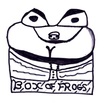
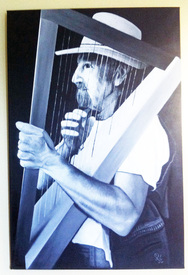
This is a photograph of a monochrome portrait by Ricardo Andrade from a monochrome photograph taken by Carolyne Locher at the Saltburn Folk Festival 2013 (shown below). I was in Ricardo's Studio at the Criamar Gallery in the Old Town of Funchal Madeira and noticed several dramatic monochrome portraits of various musicians including Tom Waite, Leonard Cohen, Noel Coward, Frank Sinatra et al. The portrait above is the result. Ricardo is a Madeiran who was educated in England where he went to Art College. He is a gifted painter who supplies the international art market with beautiful, thoughtful and sensitive paintings which reflect the vibrant colours of the Island where he lives. |
